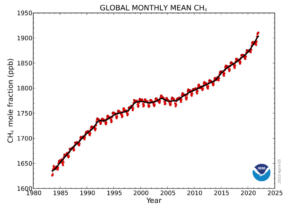Imagine growing up in a climate-damaged world. Dr. Britt Wray talks her new book “GENERATION DREAD – Finding Purpose in an Age of Climate Crisis”. Then we question the future of forests and climate with scientist William Anderegg, University of Utah. Alex footnotes official alarm about the methane crisis.
Listen to or download this Radio Ecoshock show in CD Quality (57 MB) or Lo-Fi (16 MB)
Listen to or download my 32 minute interview with Britt Wray in CD Quality or Lo-Fi (16 MB)
Listen to or download this 21 minute interview with William Anderegg in CD Quality (57 MB) or Lo-Fi (16 MB)
BRITT WRAY AND GENERATION DREAD
You know damaging climate change is just starting to roll. How do kids and young people handle that? Journalist, author, and academic Britt Wray is here to tell us with her new book “Generation Dread – Finding Purpose in an Age of Climate Crisis”. Her previous book was “Rise of the Necrofauna: The Science, Ethics, and Risks of De-Extinction”.

Eco-Anxiety expert Dr. Britt Wray
Dr. Wray is a Canadian transplanted to Stanford University and the London School of Hygiene & Tropical Medicine. She is a postdoctoral fellow investigating the mental health consequences of ecological disruption. You may be dealing with those impacts. Today’s youth certainly are.
As a science communicator, Britt Wray hosted radio shows on the Canadian Broadcasting Network, the BBC, and NPR. She is featured in articles by major publications like the New York Times and the Washington Post.
Baby boomers grew up knowing their city could be incinerated at any moment by an exchange of nuclear weapons. We were trained to dive under desks or jump into a ditch if a big flash announced the atomic bomb. I ask Britt: How is that different from the stress young people experience today?
In the book, Britt introduces us to “Earth Emotions”, Glenn Albrecht, and his concept of “solastalgia”. I would define that differently, like: mourning for the loss of the world you grew up in, where only patches of it still survive…
Wray’s book “Generation Dread” takes a three step approach. We become aware of humanity’s dangerous direction, followed by emotionally reaction, and then hopefully a transition into activism. I think not everyone follows this path. Some people go straight from ecological awareness into activism, without suffering through the feeling stage, but that is rare. Some people will become mired down in the tragedy, getting stuck there in grief with no off-ramp.
We have great universities and research institutions measuring and projecting climate science. But the psychology of climate change arises more in medical journals, including the Lancet. Should that separation continue?
Like science, business also tries to wall off emotions, especially about consequences for corporate actions. Yet millions of people go to work knowing their paycheck depends on wrecking the future of the children they love so much. That has to be damaging too.
Britt Wray’s YouTube of her TED talk two years ago has 92,000 views, which is pretty high for any climate talk. I wonder if teens and twenty-somethings still read books. Do they get most information in large well-researched arguments, or 30 second TikToks and 140 character Tweets? How can we communicate best?
Britt Wray recently signed a letter criticizing Sustainable Development Goals being based on a world-model that leads to ecological destruction. The letter was signed by many scientists, including Radio Ecoshock guests Peter Kalmus and Jem Bendell. It was sent to the United Nations conference on disasters, held recently in Bali Indonesia.
THREE EXCERPTS FROM THE BOOK “GENERATION DREAD”
THE OPPRESSED ALREADY KNOW…
“For so many people who’ve been marginalized, the oppressiveness of how bad things are is a tale as old as the hills. As a white, cis-gendered, economically secure woman, I have the luxury of dreading the future (in light of problems like climate change) while others already acutely fear the present, and have long been suffering for how they were treated by dominant power systems in the past. “
CLIMATE ANXIETY CAN BE WORSE FOR THOSE WITH MORE TO LOSE…
“Eco-anxiety researcher Panu Pihkala says that waking up to the climate and wider ecological crisis is particularly hard for middle-class citizens of industrialized nations because “the world is revealed to be much more tragic and fragile than people thought it was.” This profound disruption, which can be as severe as an internal shattering, sends them into a grief-stricken process of mourning the lost future they believed would come – a future of ecological stability. This then erodes their sense of security.”
IT’S NOT JUST CLIMATE CHANGE, BUT A PLANETARY HEALTH CRISIS
“It’s the fact that we are in the midst of an escalating planetary health crisis. Much more than just climate change, the planetary health crisis is humanity’s destruction of nature, and it is affecting everything from the climate to biodiversity, fresh water, fertile soil, clean air, land cover, the spread of infectious disease, rates of chronic disease, and, as a result, the health of all living beings. It is a civilization-changing event that is well under way, causing incredible damage and deepening existing injustices.”
AND ONE MORE – A QUOTE FROM GUS SPETH
Britt opens here first chapter with this quote from environmental lawyer Gus Speth:
“I used to think the top environmental problems were biodiversity loss, ecosystem collapse and climate change . . . I thought that with 30 years of good science we could address those problems. I was wrong. The top environmental problems are selfishness, greed and apathy . . . and to deal with those we need a spiritual and cultural transformation. And we scientists don’t know how to do that.”
SEE ALSO:
The Lancet: Articles| Volume 5, Issue 12, E863-e873, December 01, 2021 Open Access
“Climate anxiety in children and young people and their beliefs about government responses to climate change: a global survey” – Caroline Hickman, MSc et al.
“ This is the first large-scale investigation of climate anxiety in children and young people globally and its relationship with perceived government response.”
According to an explainer article by Fiona Harvey, Environment correspondent for the Guardian newspaper:
“Four in 10 young people fear having children due to climate crisis
Global survey finds most 16-25 year olds worry a lot about the future, and many feel failed by governments
“Nearly six in 10 young people, aged 16 to 25, were very or extremely worried about climate change, according to the biggest scientific study yet on climate anxiety and young people, published on Tuesday. A similar number said governments were not protecting them, the planet, or future generations, and felt betrayed by the older generation and governments.”
THAT BIGGEST STUDY ON CLIMATE ANXIETY
“Young People’s Voices on Climate Anxiety, Government Betrayal and Moral Injury: A Global Phenomenon”
23 Pages Posted: 7 Sep 2021
Elizabeth Marks, University of Bath, et al.
=============================================================================
FORESTS MAY NOT BUFFER WARMING
WILLIAM ANDEREGG
Corporations, governments and some green activists are pushing forests to offset continuing carbon emissions, or even to limit warming. Find out why new science questions all that.
Whether forests will absorb more or less carbon dioxide from the atmosphere could affect the state of the world. Forest ecosystems currently offset about one quarter of annual emissions by humans. Large multinational companies claim they use forests to offset their continuing greenhouse gas pollution. Does that really work? As important as that is, the real issue is larger: can forests help save us as the climate changes, or will trees add more carbon to the atmosphere?
Two new studies address those questions. Dr. William Anderegg is a co-author of both papers, published this May in the journals Science and Ecology Letters. Anderegg is Associate Professor of Ecology in the School Of Biological Sciences at the University of Utah.

Dr. William Anderegg
“When trees burn, all the carbon they have stored goes back into the atmosphere.”
I recommend you start with this excellent article in The Conversation, written by our guest.
“When trees burn, all the carbon they have stored goes back into the atmosphere. Trees aren’t a climate change cure-all – 2 new studies on the life and death of trees in a warming world show why.” Published: May 12, 2022
WILL MORE CARBON DIOXIDE REALLY HELP FORESTS GROW?
Climate deniers says more carbon dioxide in the atmosphere is good. More CO2 stimulates plant growth. I know one American scientist has been testing that theory in Manitoba Canada for over a decade. But we do not have conclusive evidence that increased carbon dioxide will stimulate more capture of carbon by trees. It turns out that water availability – not carbon – determines how well trees grow. If trees have more carbon dioxide available, but suffer from water stress or drought, the forests will capture less, not more, carbon dioxide. We learn about that in one of the papers Anderegg co-authored, and in our interview.
First we talk about “Cross-biome synthesis of source versus sink limits to tree growth” led by Antoine Cabon (Abstract only, paper behind a paywall). William Anderegg co-author.
Within forestry science, there has been a debate about the limits of tree growth under climate change. The primary way trees capture carbon is by photosynthesis to assimilate carbon into the trunk and limbs. But is photosynthesis the main determining factor behind carbon storage as the climate shifts? Or is there something in the way woody growth occurs that is sensitive to climate-driven changes, like drought and more heat? This study investigates that second possibility.
Meanwhile, the public and some science has studies how increasing carbon dioxide might encourage trees to grow more, thus capturing carbon (becoming a sink). Only a few continuing tests of that thesis have been done, and the results did not agree. This study finds increasing carbon may not stimulate more tree growth as assumed. Instead they find capture of carbon by trees is “…not directly dependent on atmospheric CO2 concentration…” So that is less important, perhaps misleading to the fundamental problem?
Now, new availability of much larger datasets allows better answers on what to expect from forests as the climate warms. There are big networks measuring carbon exchange, and very large tree ring data is emerging. This study managed to estimate carbon assimilation (capture) using dense data from “most of Europe and North America”. That includes many different types of environments (“biomes”) from very dry to boreal forests.
The study finds different reactions to a warming world between leafed trees (angiosperms) and “evergreens” (gymnosperms). This difference also impacts the results. Also, because the angiosperms go dormant during winter, their absorption of carbon is seasonal, whereas the evergreens are more steady.
CASE STUDY: AMERICAN FORESTS AT RISK
The second paper we discuss is “Future climate risks from stress, insects and fire across US forests”. William Anderegg is the lead author. Using current data, emissions scenarios could increase fires in the United States up to four times more than seen in recent years, and up to 1.3 times “climate-stress mortality”.
The authors find:
“…increasing climate stresses and disturbance could compromise forest C[arbon] storage, yielding manifold impacts on biodiversity, ecosystem services and carbon cycle feedbacks and undermining the potential of forests as a climate solution.”
The two papers combined call for a total re-think of the ways global climate models handle forests (as sinks or sources). Current climate models may be over-optimistic about the role forests can play as the world warms. This means it could get hotter, faster than scientists currently predict.
The studies also call into question using forest preservation or planting as carbon “offsets”. Currently, almost a billion dollars of these carbon offsets are purchased voluntarily (companies wanting to look greener). But over $280 billion in offsets (of many kinds) are purchased by polluting companies required by law to offset their carbon. That is a HUGE market, now called into questions by these two new research papers. Again, we find so-called carbon offsets are a game that do not work in the real world. That matters because the future of humanity and all species is at stake.
SEE ALSO: This earlier paper led by William Anderegg “Climate-driven risks to the climate mitigation potential of forests”
The Structured Abstract for that 2020 Anderegg paper warns:
“Widespread climate-induced forest die-off has been observed in forests globally and creates a dangerous carbon cycle feedback, both by releasing large amounts of carbon stored in forest ecosystems to the atmosphere and by reducing the size of the future forest carbon sink. Climate-driven risks may fundamentally compromise forest carbon stocks and sinks in the 21st century.
Understanding and quantifying climate-driven risks to forest stability are crucial components needed to forecast the integrity of forest carbon sinks and the extent to which they can contribute toward the Paris Agreement goal to limit warming well below 2°C. Thus, rigorous scientific assessment of the risks and limitations to widespread deployment of forests as natural climate solutions is urgently needed.”
ONE FURTHER FOREST THOUGHT FROM ALEX
I recently realized the sharp line we draw between trees and the atmosphere is wrong. The breathing of trees determines the pulse of gases in the atmosphere, from carbon dioxide to oxygen. Trees also emit a huge amount of so-called volatile organic compounds. We can’t see those clouds of trees gases, but they have significant impacts on the atmosphere, possibly including cloud development. There is amazing new science about “biogenic volatile organic compounds”. Maybe we should think of trees and the atmosphere as part of one system.
===========================================================
RANDOM HOT SHOTS – METHANE RISING
In last week’s show and blog I got the number for carbon dioxide in the atmosphere wrong. In 2010, there were 390 parts per million, not 410 ppm as I stated. My thanks to an alert listener for picking that up. But that makes the quick rise of CO2 in the last 12 years even worse! We are likely to reach 420 ppm for 2022, meaning about 30 ppm added in the last 12 years – a disaster.
But at least 20% of global warming comes not from that CO2, but from methane. NOAA, the National Oceanic and Atmospheric Administration, is worried about rapidly increasing methane in the atmosphere. As you know, methane is about 80 times more powerful as a warming gas than carbon dioxide. The Agency says:
“Scientists estimate the amount of methane emitted in 2021 was 15% greater than the 1984-2006 period. Causes for the dramatic post-2007 increase are not fully understood, but NOAA scientists have concluded that changes in isotopic composition of atmospheric methane over time point to microbial sources, likely from wetlands, agriculture, and landfills, as the dominant driver. Fossil fuel emissions, they suggest, have made a smaller contribution.”
The wetlands source was emphasized by Radio Ecoshock guest Euan Nisbet, who measured air flasks captured all over the world. The EU’s Copernicus satellite monitoring system also shows increasing methane coming from South American wetlands, and from the reservoirs of river dams.
METHANE & CO2 POURING FROM AMAZON IN MAY
Copernicus satellite monitoring
Methane wetland feedback emissions and methane from river dams. CO2 from forest degradation and clearing, Amazon switched from CO2 sink to source. #climate #methane #Amazon pic.twitter.com/qGfXCvX6y4— Peter D Carter (@PCarterClimate) May 21, 2022
NOAA reports methane increasing since 2006, with record growth last year adding 16.9 parts per billion, a 162% increase over pre-industrial levels of methane in the air. As methane increases, especially from natural sources, that forces an even faster transitions away from fossil fuels by humans. It reduces our time until the age of climate catastrophes.

I have an interview coming up on new science showing the UN Climate Framework underestimates the ways increasing methane damages the climate and our health. I am working on another big study showing humanity will have to find ways to reduce methane emissions. Otherwise, we slide deep into the danger zone, where civilizations and many species may not survive.
But getting back to Britt Wray, all of us DO need to find ways to allow honest feelings coming out of these dark threats, and to find others who are coping – or even finding their inner meaning and drive trying to save the wondrous nature that supports everything.
Everyone needs to run away from it now and then. I try for a balanced life where climate doom is kept separate from my joy in the garden, the river and the hills. More bad news just lights my fire, to make another Radio Ecoshock show for you.
Please don’t forget to help support Radio Ecoshock financially if you can. It is easy to make a one-time donation or become a monthly supporter here.
I’m Alex Smith. Thank you for tuning in – and caring about our world.
Pingback: Radio Adelaide » GENERATION DREAD